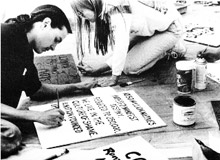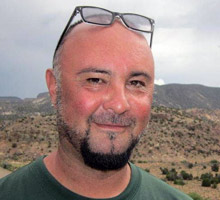“Indians in T-shirts”
The Institute of American Indian Arts, now in its 50th year, encourages its students to upend conventional expectations of Native American culture

It’s a bright-hot afternoon in Santa Fe, New Mexico, and the Indian Market is operating at full throttle. Each August, the Market fills the Santa Fe plaza, clogging it with prospective buyers and sellers of traditional Native American artwork and crafts. Here, authentic Indian art is big business: a Navajo rug sells for almost $3,000, a Pueblo clay pot for $5,500. A stage sits in the crowded center, and on it a group of elaborately costumed dancers reenact an ancient Native myth.
Twenty years ago, poet James Thomas Stevens read from this stage while studying at the Institute of American Indian Arts. He and his classmates stepped forward wearing T-shirts and jeans following a reading by local Indian poets dressed in buckskin and beating drums. “How quickly the audience dispersed when the drum ended, when they ceased to hear mention of Coyote or Raven, of how English was ‘like a razor slicing the indigenous tongue,’” Stevens wrote in 2010, remembering the incident. “We were simply Indians in T-shirts reading about who we are today.”
The writers, artists, and musicians of Santa Fe’s Institute of American Indian Arts (IAIA) have always navigated a delicate relationship with their Indian Market neighbors—often upending expectations of what it means to be a Native American artist. Since its inception, the institute has concerned itself more with the present moment than the past, encouraging its students to move beyond the traditional conventions that events such as the Indian Market offer up.
The IAIA, which celebrates its 50th anniversary this month, is the only four-year college in the United States devoted entirely to Native American arts and culture. It is known for its visual artists, but it has also made its mark on American literature. Joy Harjo, Allison Hedge Coke, James Thomas Stevens, Sherwin Bitsui, and other award-winning Native writers have their roots at the institute.
Last year’s class of 368 students represented 84 different tribes from across the United States. “Here, it’s like the United Nations,” says IAIA creative writing chair Jon Davis. He has taught students from Alaska to Hawaii, as well as First Nations students from Canada. Though Davis says the program leans heavily toward verse—the 2012 IAIA student anthology contains mostly poetry—his students also study fiction, playwriting, screenwriting, and creative nonfiction.
IAIA alumni and faculty, as well as most scholars of indigenous writing, stress that each tribal nation has its own unique culture and language, resulting in differing tribal aesthetics. “Most Native poets do not share stylistic tenets, so a school of poetry is not really apparent in the way that schools normally are,” says poet Allison Hedge Coke, who graduated from the IAIA in 1993.
Interestingly, it is only at this school for Indian artists that many Native writers feel emancipated from writing “Native American poetry.” Guided by the Chinese American poet Arthur Sze, who directed the program for 22 years, the IAIA’s creative writing program has forged a new tradition by embracing many traditions. This has resulted in a wide variety of poetics emerging from the institute, from Hedge Coke’s first collection, Dog Road Woman, which references her experiences working on farms and in factories, to James Thomas Stevens’ love poetry that is interwoven with historical allusions.
“When you go to the IAIA, you’re in an indigenous space, a place where your perspective is part of the fabric of knowing, and it’s respected,” says Diné Navajo poet Sherwin Bitsui. “If I had gone to another school, I think there would be a lot of investment in me having to explain everything politically, or having to speak on behalf of all Native people.” At the IAIA, Bitsui says he was “free to begin telling without always having to explain.”
The IAIA, founded in 1962 as a high school under the auspices of the Bureau of Indian Affairs, was the brainchild of Lloyd Kiva New, a Cherokee artist and designer. New was deeply concerned with his students’ ability to achieve in the contemporary art world, writing in 1964, “The Institute assumes that the future of Indian art lies in the Indian’s ability to evolve, adjust, and adapt to the demands of the present, and not upon the ability to re-manipulate the past.”
This approach was controversial among Native artists who labored to preserve their ancestral artistic traditions. But New’s vision drew national attention. After visiting the school in 1967, art critic Robert Coates praised New’s “revolutionary approach” in The New Yorker. That same year, LIFE magazine featured the school in a photo essay. Actor Vincent Price, who served with New on the Department of the Interior’s Indian Arts and Crafts Board during the 1960s, threw his support behind the IAIA’s young writers. He sponsored a yearly poetry award, reading the winner’s poem in his distinctive voice before presenting the prize.
In the 1970s, the high school program was phased out and the school became a two-year college. The IAIA then entered a long rocky period, plagued by funding difficulties during the 1980s and 1990s. But during this time, the creative writing program found an unlikely champion in Chinese American poet Arthur Sze, winner of a 1997 Guggenheim Fellowship and author of nine books. In 1984, Sze, who had been living in Santa Fe for more than a decade, was recruited to teach at the institute. He was married to a Hopi woman at the time and feels, as he put it, “a kind of cultural connection” with Native peoples. Initially, he says, he took the job because “I felt I could make a difference there. I took it year by year.”
Sze remembers fistfights in the hallways over tribal differences, but also flashes of extraordinary talent in the classroom. “When I started at the institute, I was surprised with how creative the students were—that they were willing to take risks with the language,” says Sze. “They didn’t know how good they were.” In 1989, after yet another budget cut, Sze found himself in charge of the program, and the sole member of the creative writing faculty. He remained at the IAIA for the next two decades. By the time he retired in 2006, the institute boasted a four-year bachelor of fine arts program and a sleek new 140-acre campus, funded by government grants and private donors.
Rather than teaching only the Western canon, Sze decided to focus on world literature, a curriculum that is still in place today under Jon Davis. Students read the work of Japanese writer Akutagawa Ryunosuke, Chilean poet Nicanor Parra, and Spanish poet and dramatist Federico García Lorca. The faculty has invited poets from Iraq, Colombia, Germany, Slovenia, Siberia, and Kenya to visit. “It was very empowering to see beyond the Western curriculum, to take a more global approach,” says Bitsui, who graduated in 1999.
Many alumni mentioned how influenced they were by Sze’s introduction to classic Chinese poetry, as well as the way he helped them translate these poems into English and even their own Native languages. Allison Hedge Coke said she saw parallels between lyric and celebratory Chinese poetry and the use of those forms in traditional Native poetry. “We could totally relate to those poetic structures in our own genetic history,” she says.




